FOSS Backstage 2025: wrap up
FOSS Backstage 2025 wrap up recap
Open Source Design @ FOSS Backstage
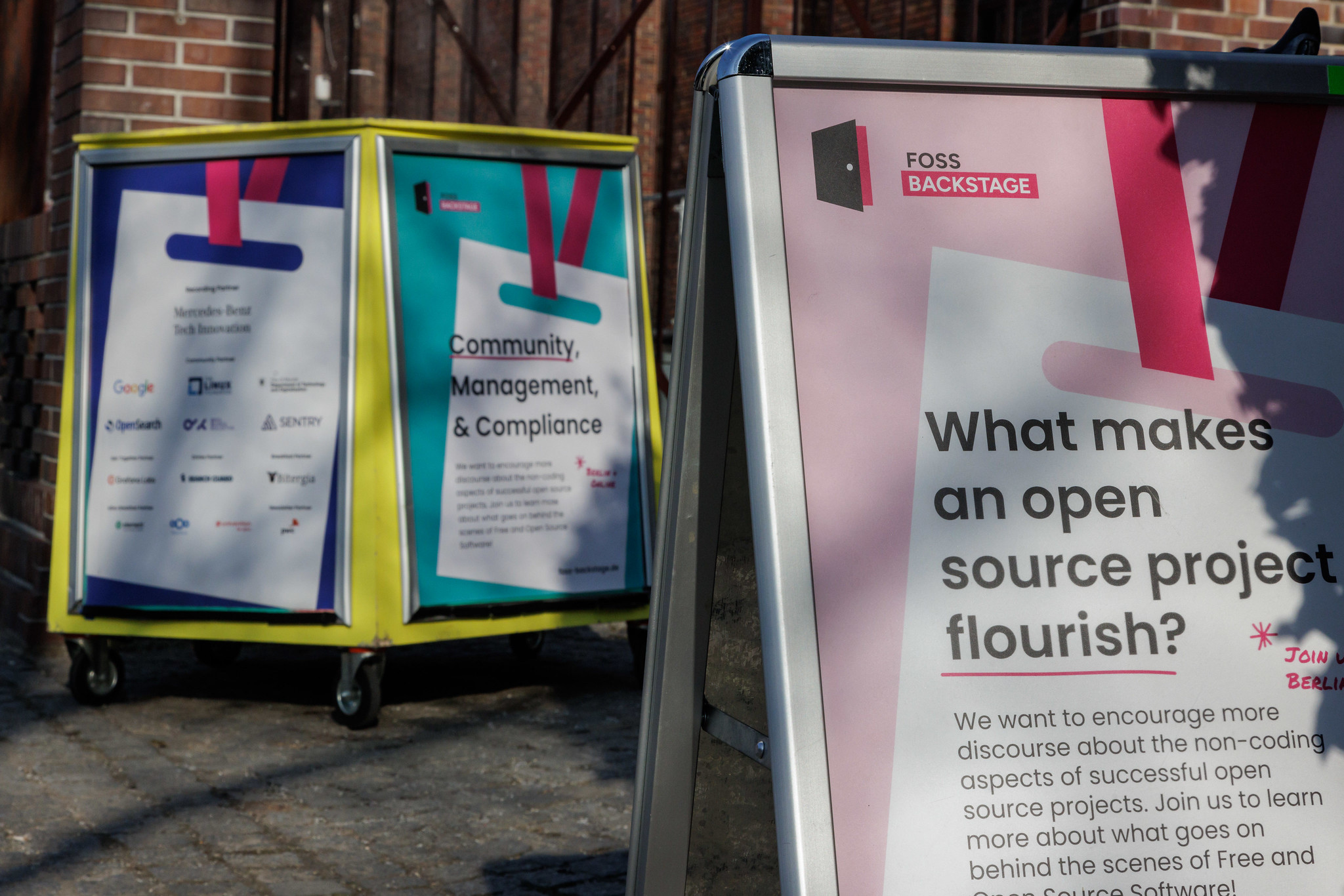
FOSS Backstage in 2025 has now been running since 2017 and FOSS Backstage Design is now in its second year. FOSS backstage is held in Berlin (and online) typically in early March and in 2025 it was held on March 10th and 11th and FOSS Backstage Design was on the 12th of March 2025.
This year, Open Source Design was able to support FOSS Backstage Design by using our community open collective fund to ensure the day had the same venue as FOSS Backstage’s main track. You can find more information about the costs on our Open Collective page as well as discussed in our monthly community meeting and the FOSS Backstage organisers maintained a forum thread in the lead up to the event
As for the decision to spend our funds this way, there were extensive discussions held by the core maintainer team in a group chat we maintain privately from the wider community in order to discuss any matters that would require secure conversations (e.g. so as not to risk leaking login information etc.) There were mixed views on supporting these costs but ultimately, when asked the majority of active core team maintainers for open source design as well as the wider community members asked in Jan 2025 / Feb 2025’s community meetings were in favour of Open Source Design using it’s collected funds to ensure that this event had a venue that was accessible to those that wanted to attend. Offering this funding also allowed us to speak a little on open source design’s mission and goals as a community to the audience in attendance and show public support for any organisation holding meetings, events and conferences that platform design in open source and open source design in the FOSS community.
This articles author (Eriol Fox) self-funded their own attendance to FOSS Backstage 2025 and FOSS Backstage Design 2025 so that they could write this article for Open Source Design’s community and also ensure that Open Source Design Community was represented at the event. Eriol is also part of the Program Committee of FOSS Backstage and has been for 2 years.
Read the recap from the FOSS Backstage conference organisers here

The design talks for FOSS backstage
This year FOSS Backstage not only ran a day of design (FOSS Backstage Design) but also had a number of design talks throughout the main 2 day conference. These talks included topics around the usability of critical civic crisis technologies, how OSS organisations are understanding and building out their design processes for the wider community, the importance of cultural contexts with language orientation, design for command line interfaces and how open source designers are building out community learning resources so that more designers can be onboarded into OSS contribution.
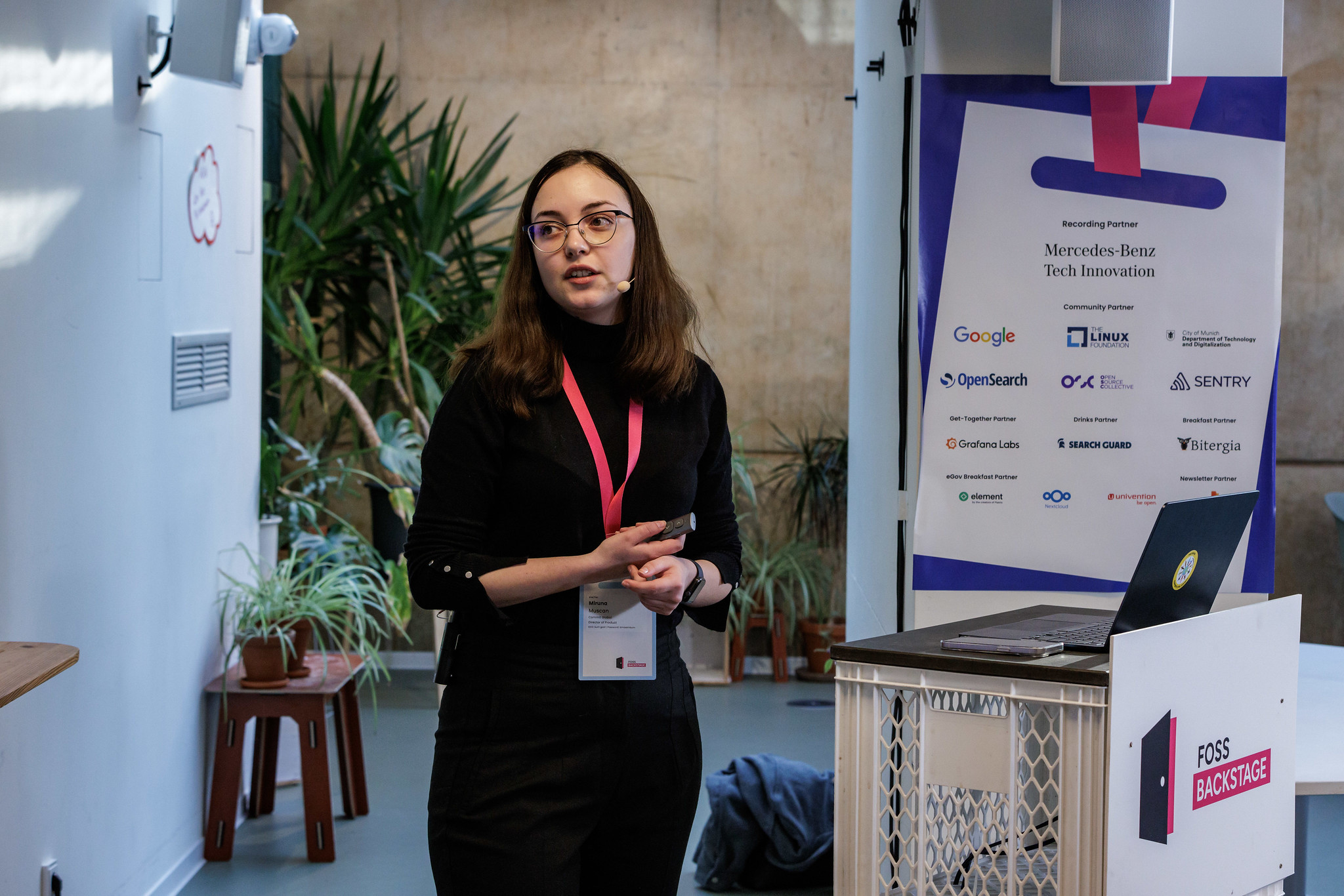
Building Resilience:UX Strategies for Crisis-Responsive Tech by Miruna Muscan
Miruna shares the story behind Commit Global’s legal guidance module, designed from the ground up to address the urgent needs of refugees at the Ukrainian border. Built with inclusive UX principles, The legal guidance tool adapts to evolving needs in real time, making complex information accessible and straightforward. Through live testing, human-centered design, and research on the ground, Commit Global developed a humanitarian digital framework that doesn’t just respond to user needs, but rather it anticipates them. One of the key elements of Miruna’s talk is about how technology that really helps people is rarely the ‘cutting edge’ or trendy technology but rather technology that is user focused.
Watch Miruna Muscan’s talk here

Bridging the Gap Between Designers & Open Source Communities by Nina Rojc, Leia Ruffini, Kola Ojoodide
Nina, Leia and Kola explore the challenges of design contribution in open source projects and the issues faced by designers and maintainers. They conducted a survey with both designers and open source maintainers, as well as in-depth interviews with several designers to get a closer look at their experiences. In the talk they share key findings, including the biggest obstacles designers face—like the intimidating nature of contribution platforms, confusing documentation, and a lack of clear entry points. They then move onto practical strategies to overcome these challenges. These findings then inform work that the team hopes to share widely with the OSS community in order to alleviate some of the challenges identified in the surveys and interviews across the research.
Watch Nina, Leia and Kola’s talk here
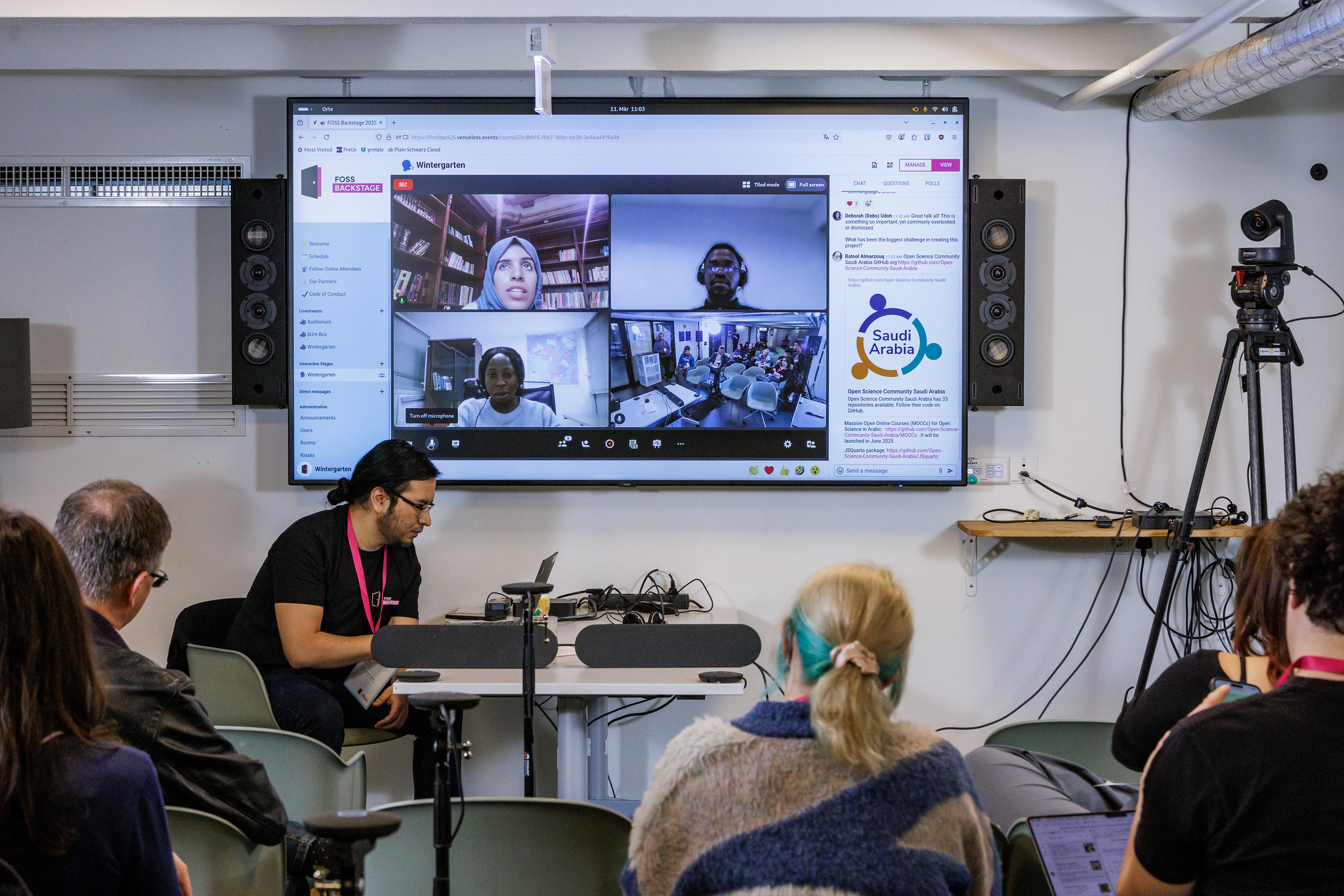
Right-to-Left, Left-to-Right: Rethinking Multilingual Design by Batool Almarzouq, Goodnews Sunday Sandy, Richie Moluno
Batool, Goodnews and Richie detailed the importance of careful and considerate design of multilingual technologies. When designers create interfaces without an understanding how these interfaces are used and read in a language with a right-to-left reading direction like Arabic , there will be minor misunderstandings at best and a completely unusable technology/interface at worst. In addition, “default”, english-based text display and critical UI interaction elements can mislead a user (e.g. a ‘back’ button being placed in a top left or left hand side of the screen from left-to-right users). These default placements mean that those reading right-to-left are working harder to ‘figure out’ the logic of left-to-right reading and contexts. This talk is a must watch for those interested in fully inclusive design across languages.
Watch Batool, Goodnews and Richie’s talk here

Open Design Guide by Christoph Ono, Eriol Fox
This talk introduced the opendesign.guide which is a project created and maintained by designers across the bitcoin design community. The purpose of the open design guide grew from the speakers spending time over the years mentoring and supporting designers new to OSS to get into contributing. Both the speakers wished that there were public and comprehensive resources to help them through the mentoring process but writing guides and resources about how OSS works and how you can contribute design to OSS is nuanced and specific to each designer. Most of the problems then, with writing guides, is that a guide written by one designer about their perspective will not be broad enough for the wider OSS community. With the Open Design Guide, AI was used to write the first version and then it was edited, improved and built upon by holding ‘reading group’ community calls.
Watch Christoph and Eriol’s talk here
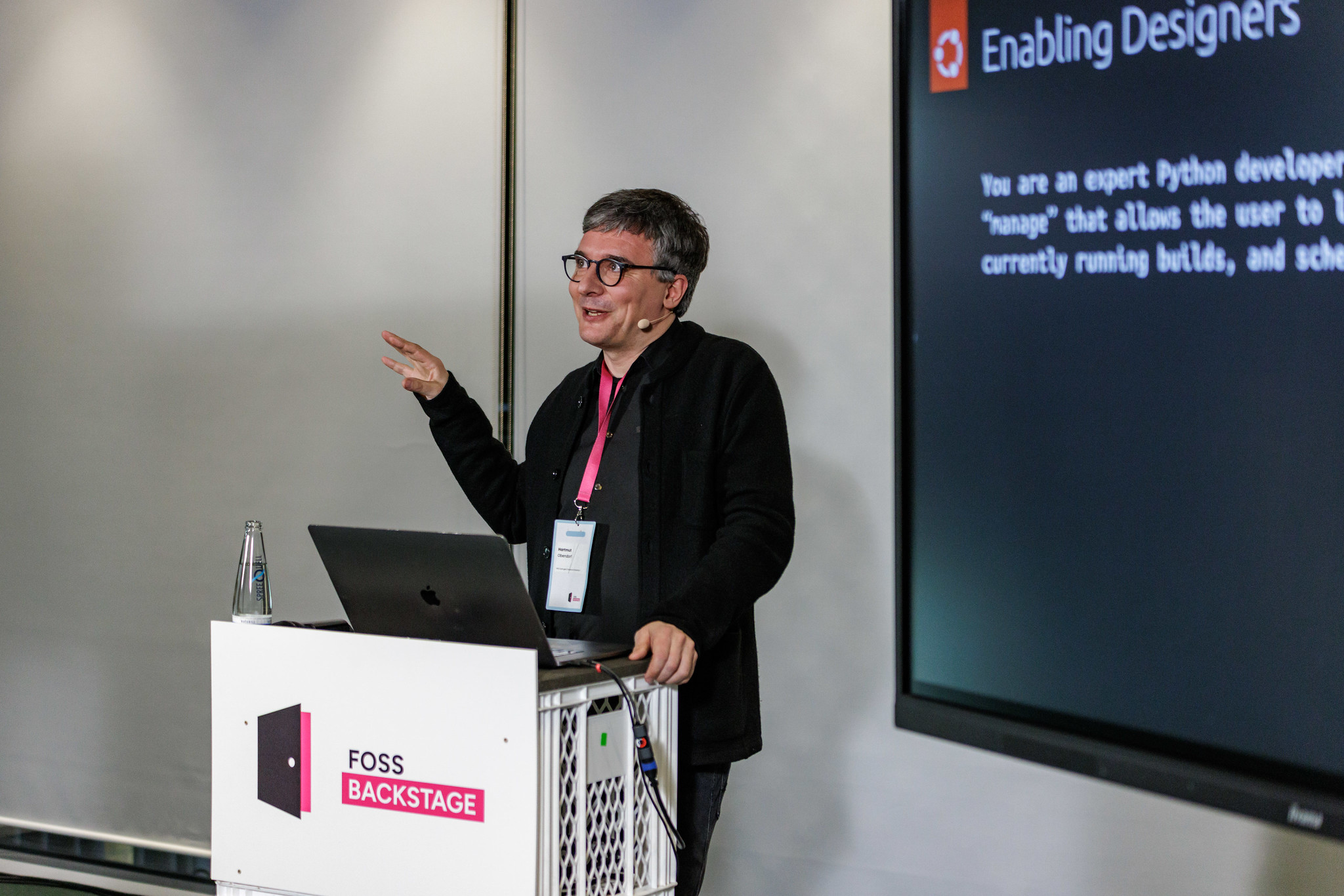
Designing is for GUIs only? CLI Design as a shared practice by Hartmut Obendorf
OSS projects are used to not having a designer. What would you ask one if you had them available? To look at your Command Line Interface? (CLI) This is exactly what you should do! In this talk, Hartmut goes into depth about how information architecture and conceptual architecture is critical in designing for command line interfaces . This dives deep into the use of ‘experts’ that interact with OSS primarily through prompts in the terminal. The command line is an environment that changes its state continuously, making a good design both important and challenging. Designing for command line interfaces also grapples with the assumption that ‘design’ is not needed, therefore advocating for usability and accessibility in the command line is difficult. Watch this talk to get some great guidance on how to start designing for text-based interfaces.
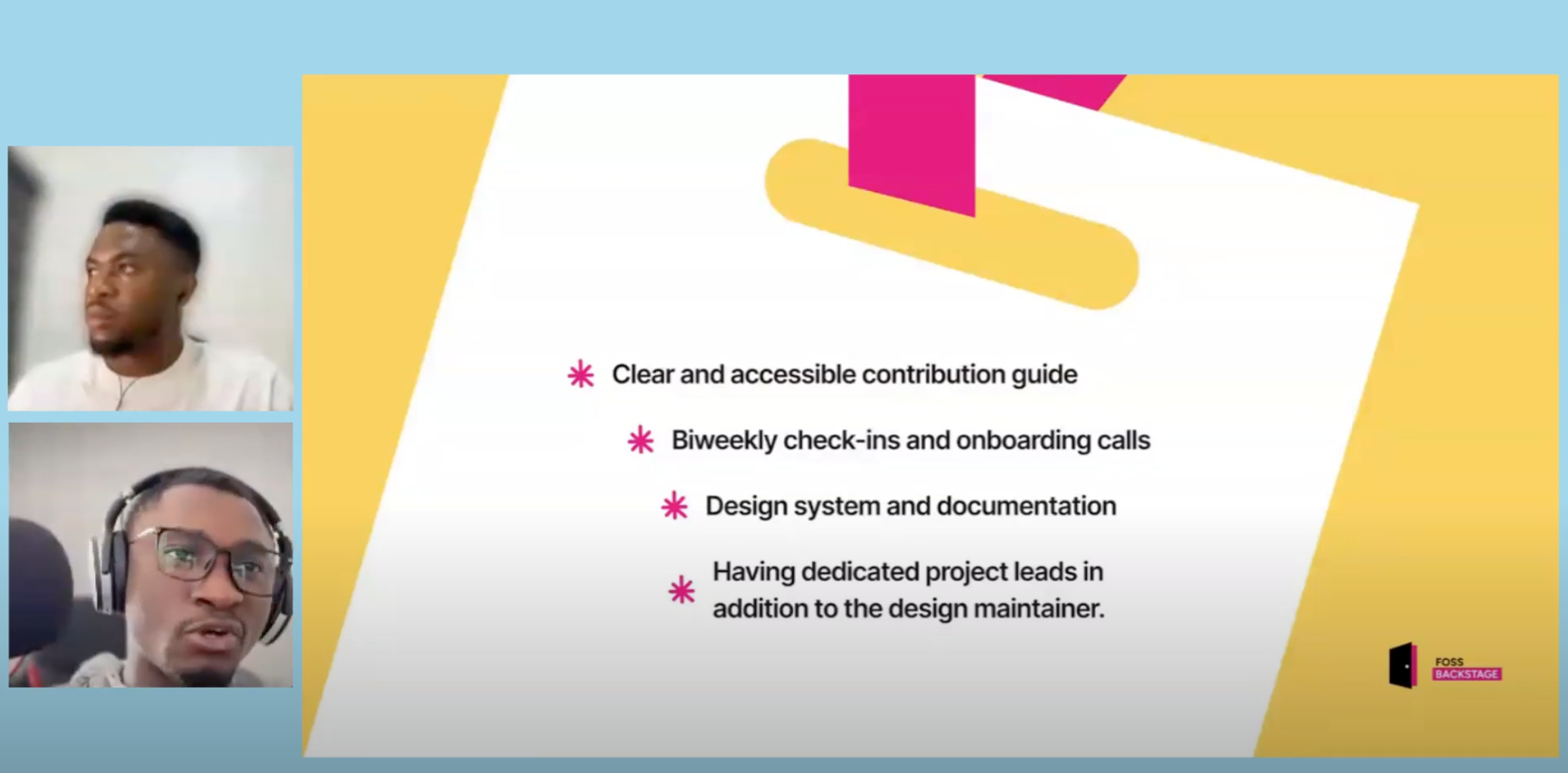
Onboarding Designers into Open Source Projects by Oluwadunsin Emmanuel Omole and Kingsley Mkpandiok
For Open Source Software, developer contributions are essential. While involvement of developers is often thought about, projects are not always prepared to integrate designers. This talk uses CHAOSS, the “Community Health Analytics in Open Source Software”, as a case study, exploring successful strategies used by the CHAOSS Africa design team to create an inclusive and productive environment for designers in open source. We will examine the specific challenges faced when integrating designers into a community primarily driven by developers, such as differing workflows, communication styles, and contribution processes.
Watch Oluwadunsin and Kingsley’s talk here
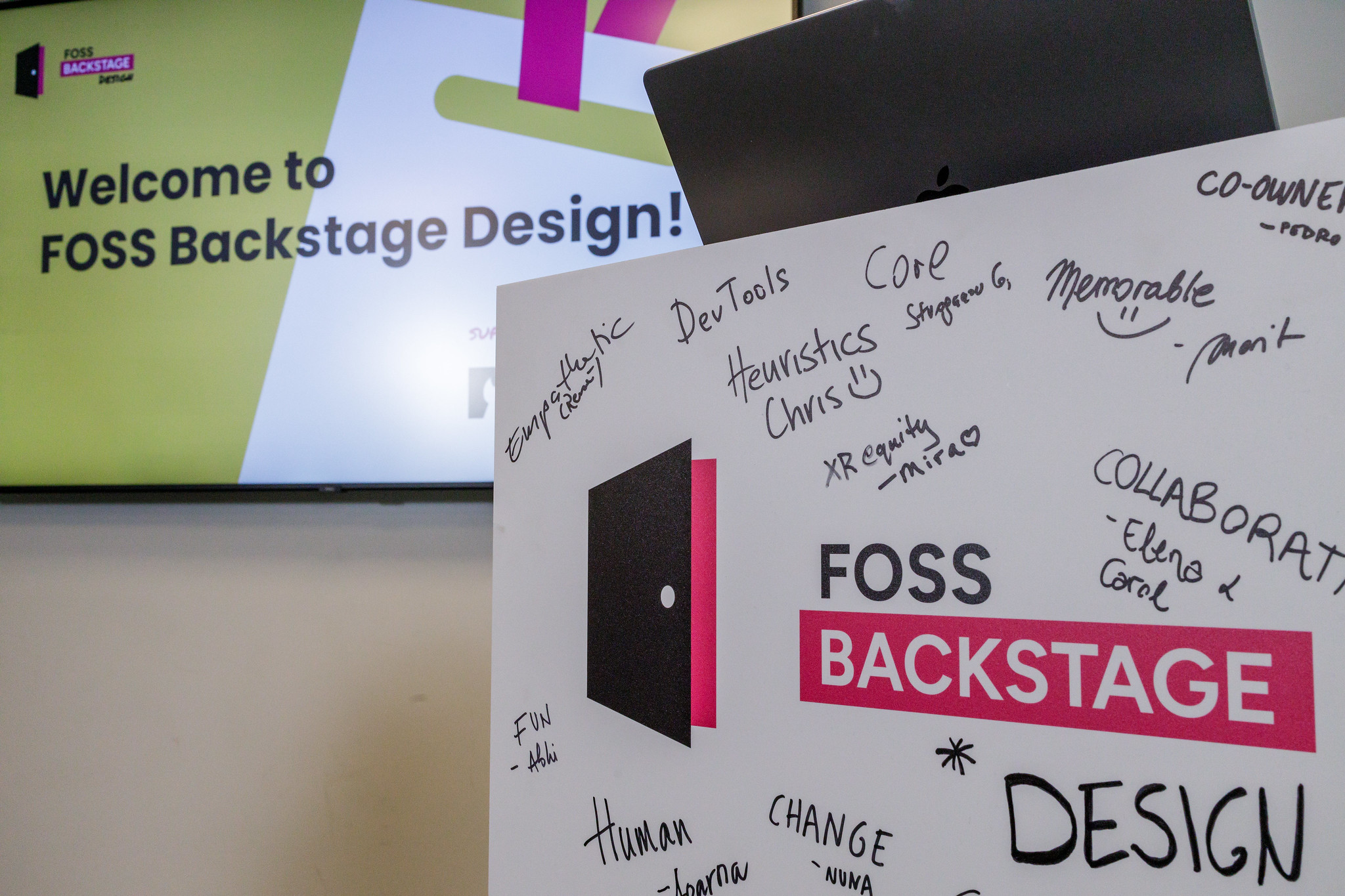
The design talks for FOSS Backstage Design
FOSS Backstage Design’s day kicked off with three fantastic talks by Martin Keary, Marta Marczykowska-Górecka and Tobias Bernard. All the speakers presented on common design in OSS topics but from their own unique experiences. There are common themes across the talks, from communication across role divides to both designers and developers getting intensely nerdy about their specific domains. The most common thread being that no matter what you’re contributing to the OSS, you’re there because you support free and open software and ultimately want it to be used, enjoyed and valuable to any user.
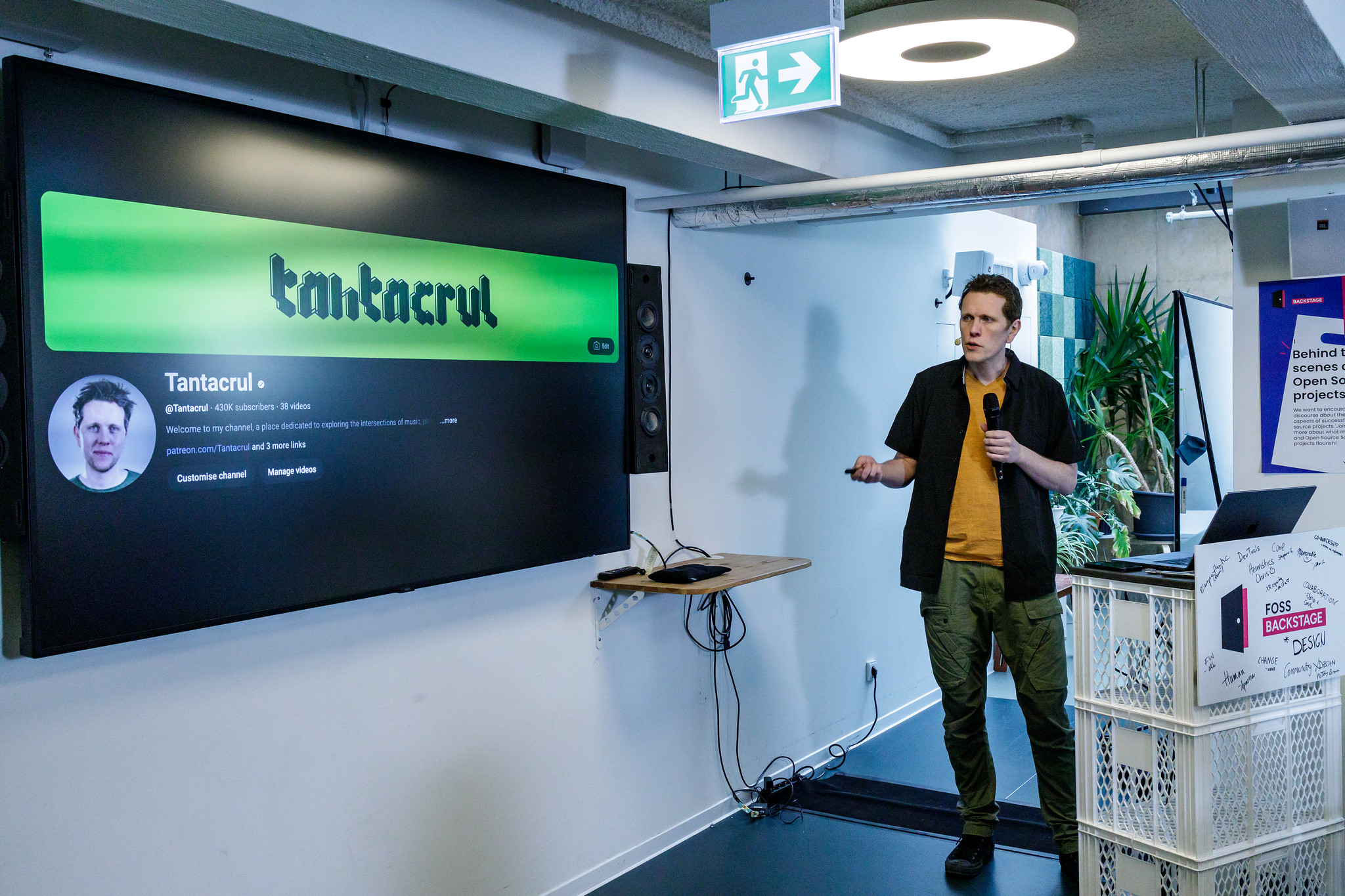
Achieving Excellence in Open Source Software Design by Martin Keary
Martin Keary aka Tantacrul kicked off FOSS Backstage Design with a talk that spanned both valuable general insights into design in open source alongside the specifics of designing for complex interfaces like Audacity in a way that is incremental and prioritised users’ quick visual understanding of the UI,reducing ‘pop up’ tools and designing more intuitive ways of expressing functions of an interface that matched the human expectations e.g. changing a ‘click to show toolbar to move an audio snippet’ to a click and drag ‘grabbing hand’ icon.. Martin also speaks to designing digital music notations that were accessible and legible both to advanced and new users with Musescore and some very funny moments from usertesting sessions with artist-users trying to puzzle out certain features in Inkscape.
Watch Martin Keary’s talk here
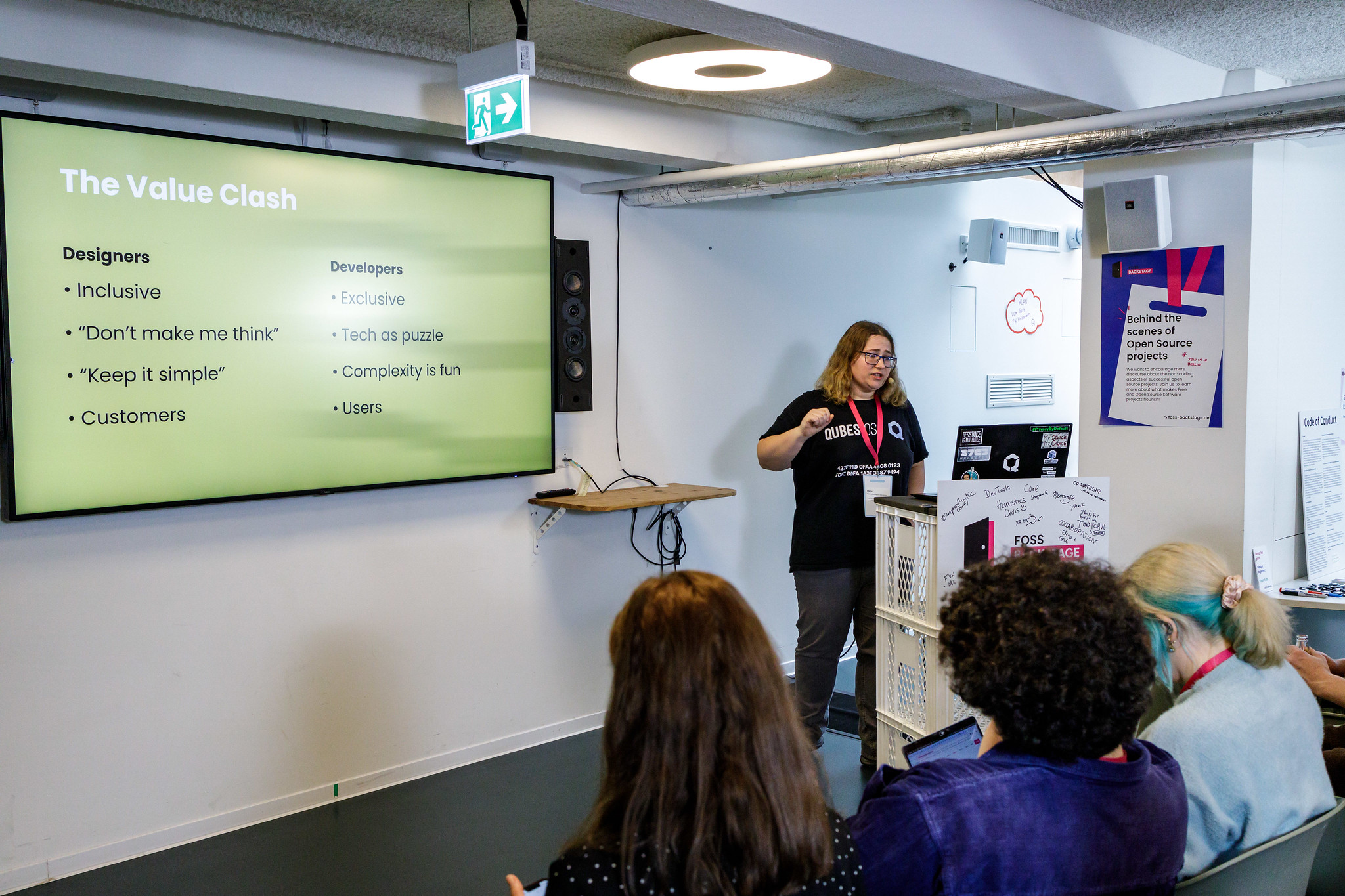
Beyond Looking Good: How To Talk To Developers About Design by Marta Marczykowska-Górecka
Marta, who is Qubes Manager, takes us through some of her experiences working with OSS developers, hackers and activists from the human rights OSS space. Marta speaks about how she advocates for humans in the OSS tech space, talking about how important communication is in the relationships between designers and developers and how to meet developers where they are at in terms of design understanding. Marta gives us practical advice on how to better connect with OSS developers and how to raise your voice as a designer in OSS.
Watch Marta Marczykowska-Górecka talk here
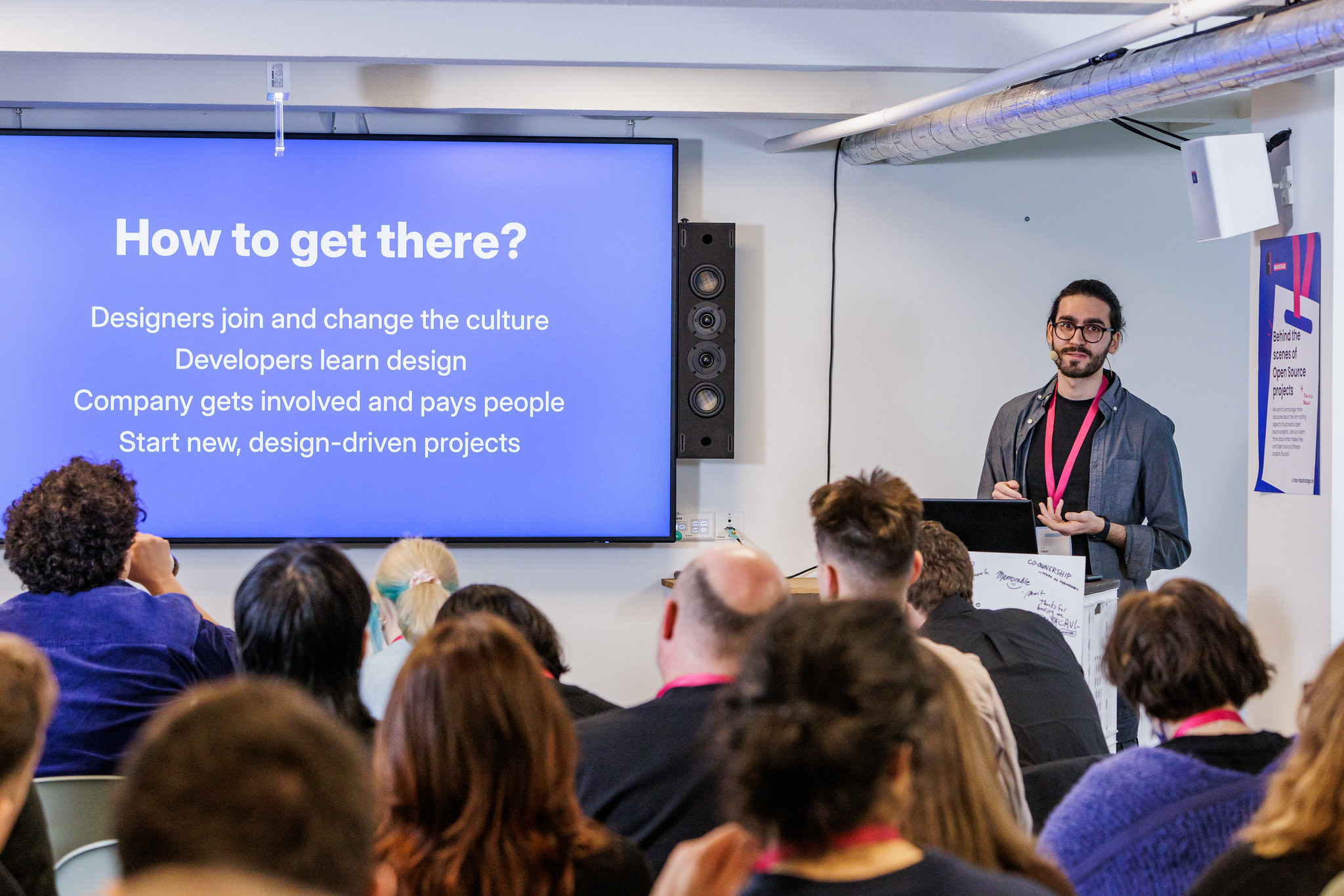
GNOME Design: A Report From the Trenches by Tobias Bernard
Tobias speaks about designing but also being embedded in the Gnome community. Tobias shows how design in FOSS allows it to break the constraints of only being for ‘nerds and hackers’. This evolves into how the design system for gnome applications has enabled both highly usable, accessible and consistent tools across the Gnome ecosystem while also removing the pain of styling those elements being the responsibility of developers. The design system also simplified the app icon design process through well established styles as well. Tobias goes into detail about the way that the design team are involved in projects in Gnome as well as the processes involved, from mock-up and design libraries to the upstream development.
Watch Tobias Bernard’s talk here
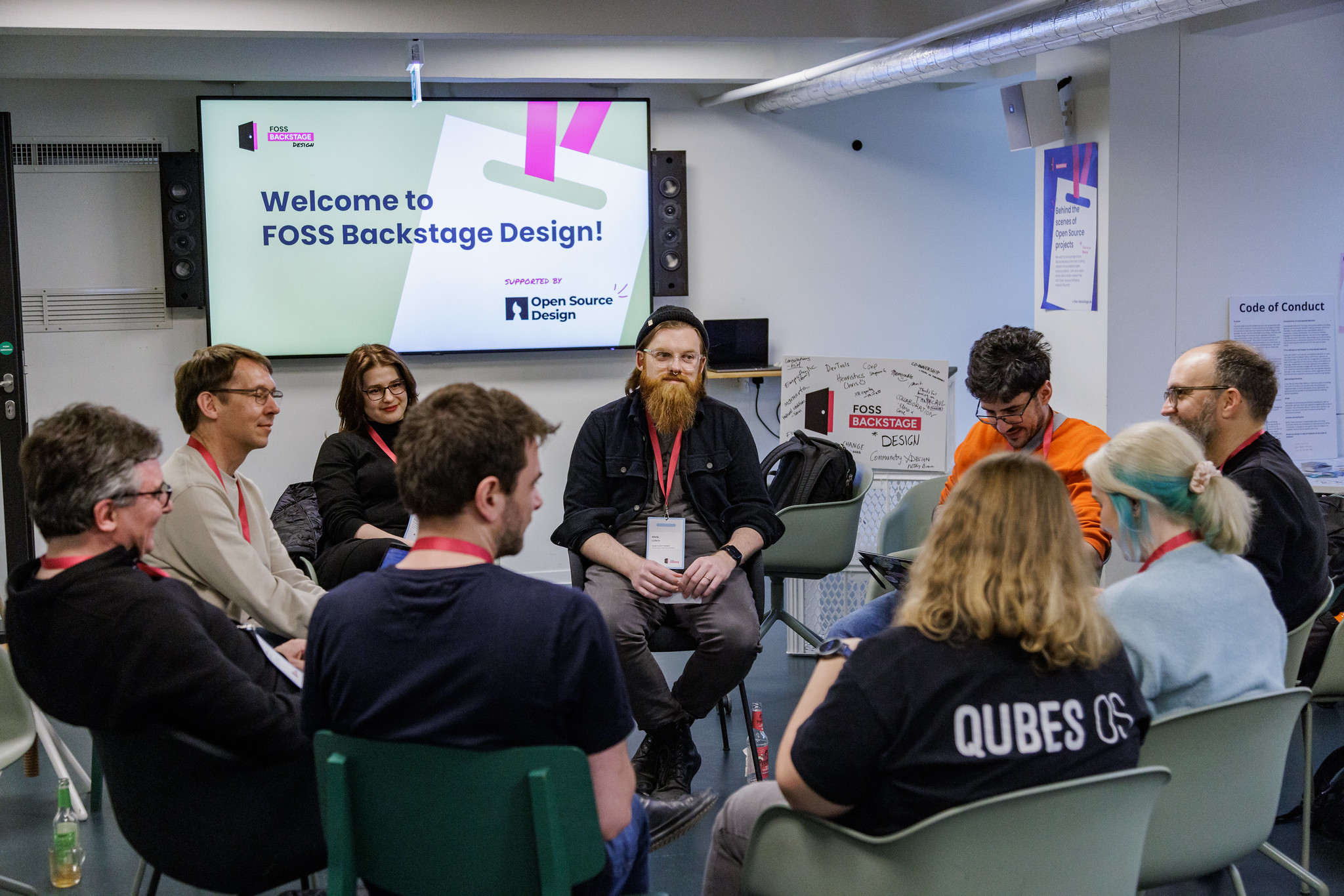
The FOSS Backstage Design ‘barcamp’ aka pitch a discussion topic and then vote!
After the talks we move into a ‘barcamp’ afternoon. All attendees had time to write what kinds of conversations and sessions they wanted to see happen for the remainder of the afternoon. These were then voted on and 3 sessions were run in parallel for 3 1 hour time slots. Notes were taken by volunteers and summaries can be found below.
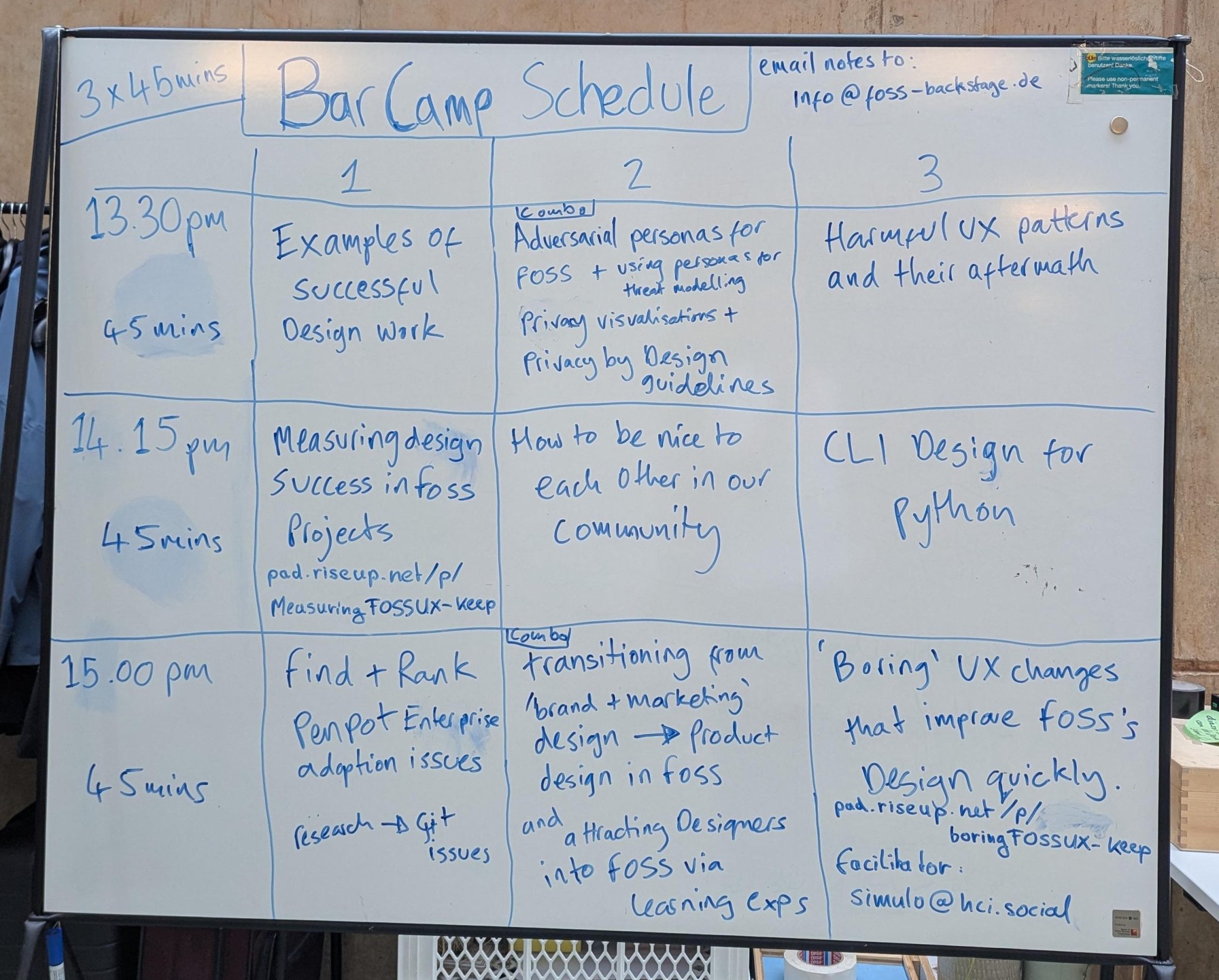
The selected topics are listed below with some sessions having summary notes and others that were more private do not have summaries
You can read the full collected notes hosted by FOSS Backstage .pdf here
The least you can do: The boring changes that improve UX quickly These tasks are easy to do because they are usually separate from complex coding work. Despite their value, they’re often ignored because they’re not as “exciting” as redesigns or new features. Examples of Small, High-Impact Fixes:
- Accessibility (a11y) improvements – Increasing contrast between text and background.
- Better labelling – Adding labels to icons, ensuring labels are clear and consistent.
- Sharpening icons – Small visual refinements that improve clarity.
- Tooltips & microcopy – Filling in missing descriptions to help users.
- Consistent terminology – Ensuring naming is logical and standardized across the project.
Examples of Successful design work A private discussion where designers in FOSS projects spoke about projects they’ve had experience with and how they would describe and express ‘success’ in those projects.
Measuring design success in a FOSS project This discussion began with defining what success is or can be within any given OSS project. The discussion then moved on to how hard it is to measure success, communication sometimes stops after the design engagement, so designers don’t have access to feedback. This then moved onto values, principles, metrics and ways of gathering and finding feedback and how to see the bias in feedback.
Harmful UX patterns and their alternatives Various reasons for harmful UX patterns manipulating users like deliberate attempts to manipulate users to satisfy a business goal or accidental ones, because there isn’t enough knowledge/feedback. An example of UX pattern mentioned in one of the talks at FOSS Backstage: Creating addiction (getting people “hooked”).
“Marija: there is a dissonance that weaponizes the general principle of “keeping users engaged”, originally as a metric for product quality, which then becomes an aim to create a dependency, or create growth per se to satisfy shareholders.”
What are good starting points for designers moving into product design to support FOSS? New people need a point of contact – Without guidance, new contributors may not know where to start. Promote experienced community members who can help others get involved and small, achievable, and impactful tasks are ideal for newcomers to FOSS. Open-source repos should be structured clearly so contributors know where to report issues and submit fixes.
Find and rank issues for Penpot enterprise adoption This discussion focused on what we believe Penpot needs to implement to become a fully viable alternative design tooling option for ‘enterprise’ level organisations and companies. These implementations needs included: More options for feedback gathering beyond prototype link sharing and commenting, ways to justify/explain design decisions in designs, branching, approval and merging, tracking the history of design changes, fixing performance issues, implementing design tokens and having a lofi, wireframing mode.
CLI Design for Python One Design challenge is that CLIs are so easy to build for individual teams that it is very hard to create a unified appearance. There are different approaches to CLIs in Linux and no enforcement but could it help to push standards compliance to code-checking tools?
Privacy by design & Adversarial personas for FOSS A conversation that centered on privacy and security in FOSS projects and how those aspects are dealt with across tools/software. How can designers, typically side-lined in privacy and securities ‘deeper’ technical work, better understand how to address these concerns from a design perspective while establishing knowledge and standards for design.
How to be nice to each other in our community Private discussion centering on how to be supportive, collaborative and kind in a ‘scarcity’ environment like OSS and Design in OSS.
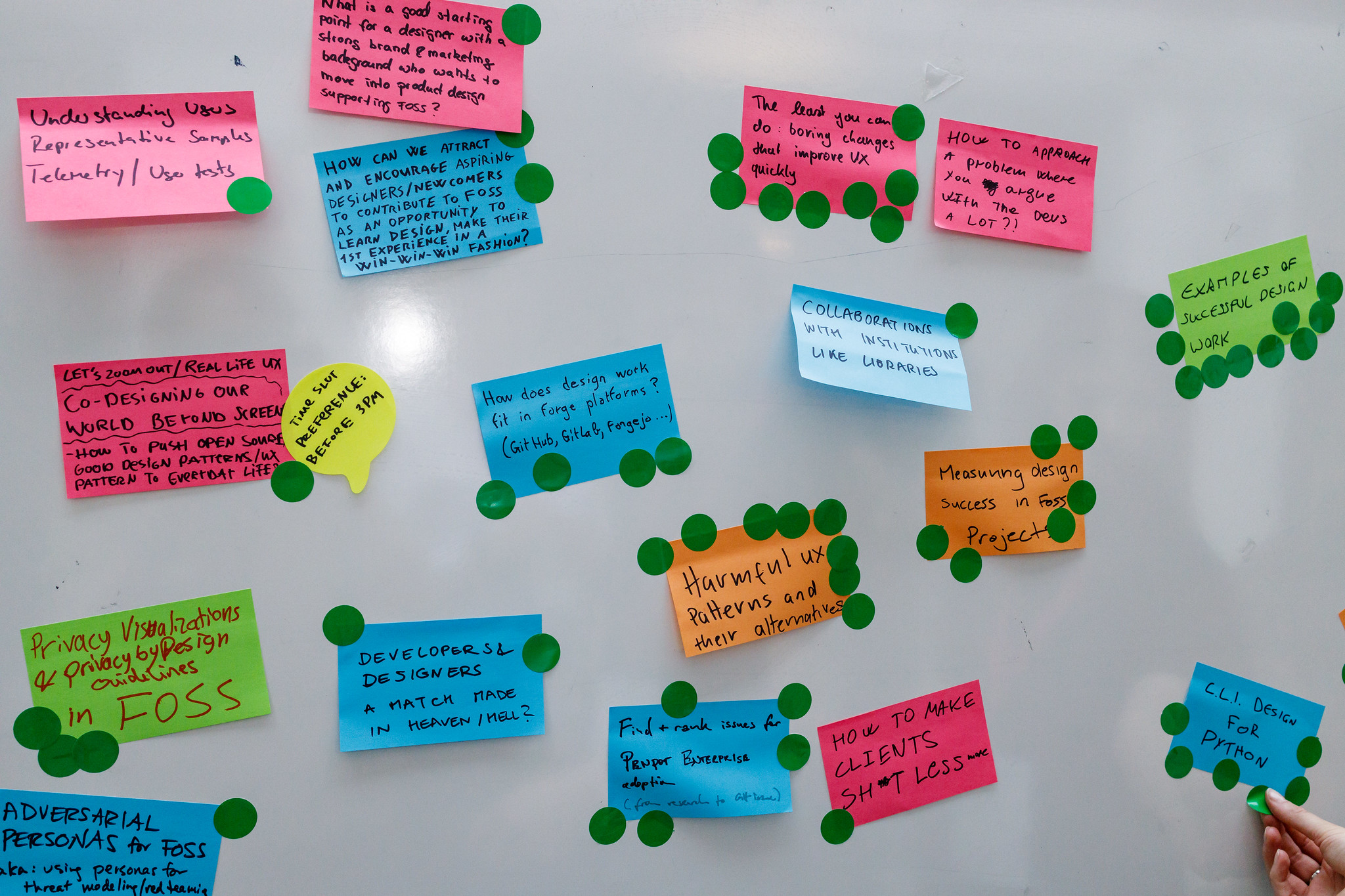
Authors final thoughts
In the ‘post’-covid (is it over really?) era, where we saw many OSS foundations and organisations struggling to maintain already tightening budgets. Who now faces the onslaught of challenges to sustainability and existence across the rapidly changing (for the better?) tech ecosystem. It feels increasingly difficult to find events and communities carving out the space for the less prominent ways of supporting and contributing to OSS - design (and all of ‘designs’ subsidiary practices aka UI, UX, Usability, Accessibility, user research etc.). Maintaining design’s presence and relevancy to OSS continues to feel like pushing a boulder up a hill (in this author’s opinion). But the more we’re able to come together as a community of designers, around our commonalities as both designers in proprietary commercial spaces as well as open source software spaces, we can support the events and communities that support us, support not only our contribution labour, but also our advocacy and relevancy in OSS.
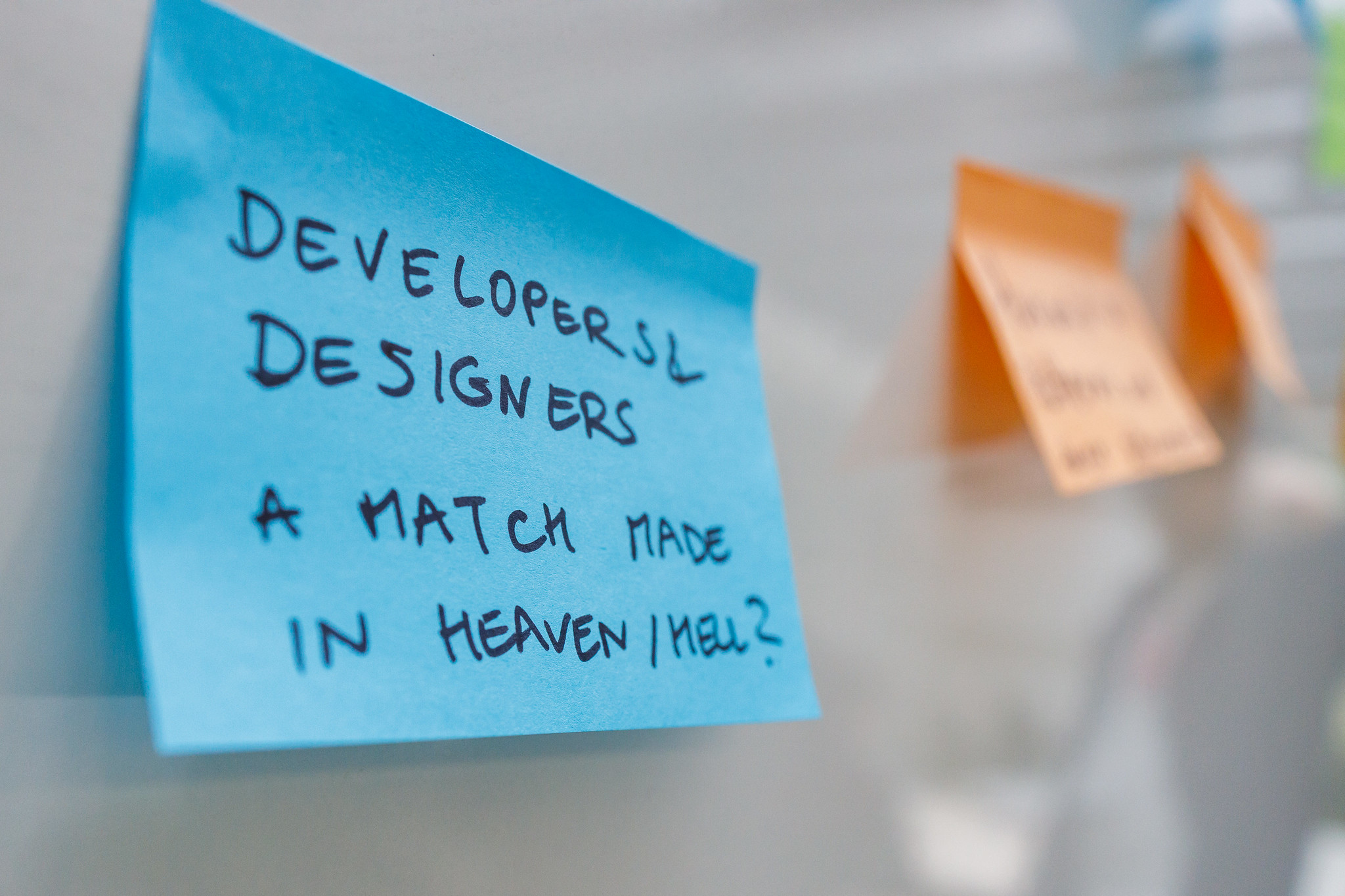
Credits and thanks
Thanks to the Open Source Design core maintainer team broadly and the wider community for discussing sponsoring FOSS Backstage.
Special thanks to the OSD maintainers and members in attendance Elio Qoshi, Jan Dittrich and Julia Racsko.
Thank you to Plain Schwarz (especially Alex, Paul, Sven & Anne) for organising FOSS Backstage and FOSS Backstage Design.
Thank you to the event photographer Jan Michalko the photos on Flickr can be found here
Written by Eriol Fox Proofread and edited by Jan Dittrich